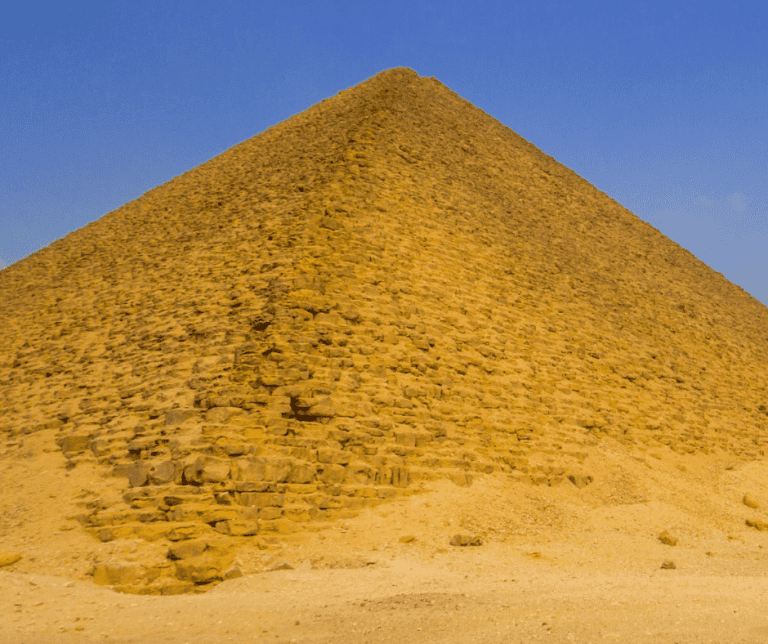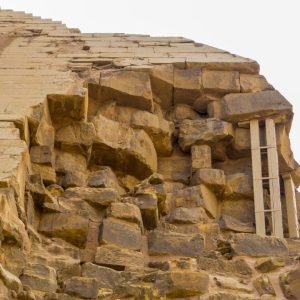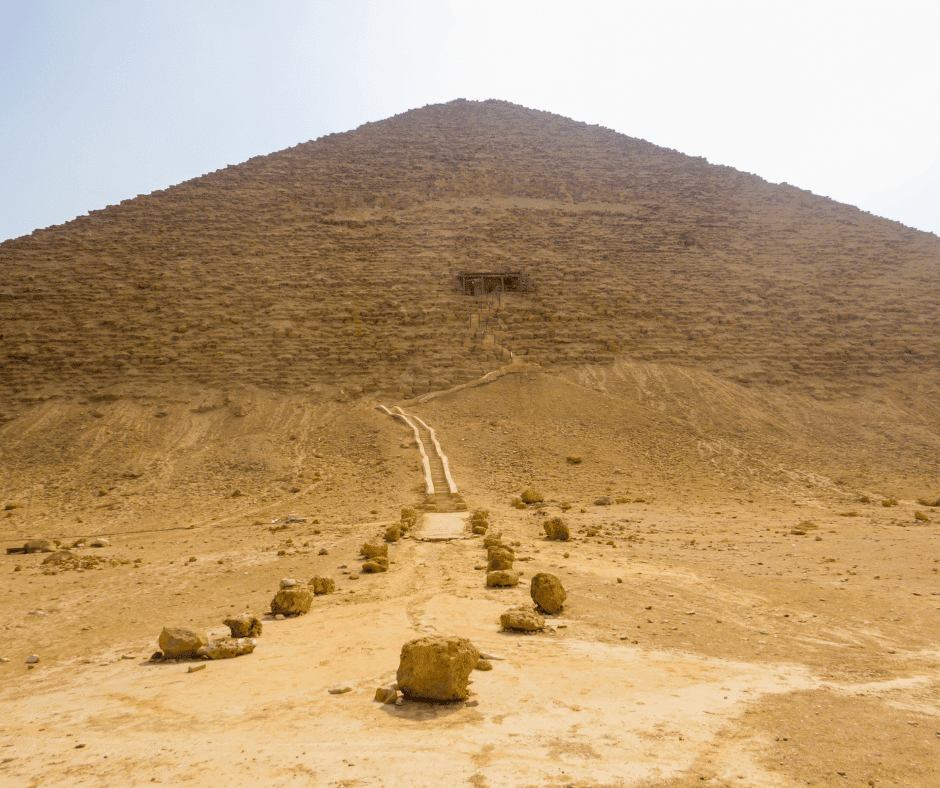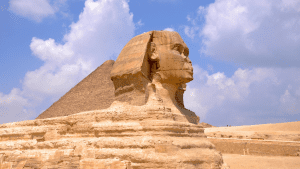
Home » Weekly Blog » Exploring Egypt’s Architectural Marvels: The Red Pyramid and the Bent Pyramid
Exploring Egypt’s Architectural Marvels: The Red Pyramid and the Bent Pyramid
Table of Contents
Introduction
Egypt’s pyramids stand as timeless monuments to the ingenuity, ambition, and spiritual fervor of one of history’s most fascinating civilizations. When most people think of Egyptian pyramids, the towering Great Pyramid of Giza often comes to mind. However, Egypt’s landscape is dotted with numerous other pyramids, each with its own unique story and architectural significance. Among these, the Red Pyramid and the Bent Pyramid hold a special place in the annals of ancient Egyptian history. These structures not only showcase the architectural evolution that took place during the Old Kingdom but also offer a glimpse into the ambitious reign of Pharaoh Sneferu, a ruler whose contributions to pyramid building were unparalleled.
In this blog post, we delve into the captivating stories and architectural marvels of the Red Pyramid and the Bent Pyramid. From their historical contexts to their unique design features, we will explore what makes these pyramids exceptional and why they are essential stops on any Egyptian tour. Whether you’re a history enthusiast, an architecture buff, or simply someone dreaming of walking among the relics of ancient Egypt, this post will provide you with a wealth of information and inspiration.
Join us on a journey through time as we uncover the secrets of these ancient wonders, understanding their cultural and historical significance, and offering practical tips for visiting these awe-inspiring sites today. By the end of this post, you’ll see why a visit to the Red Pyramid and the Bent Pyramid should be at the top of your travel bucket list, and how experiencing these lesser-known pyramids can add depth and richness to your Egyptian adventure.

The Red Pyramid: A Masterpiece of Sneferu's Reign
Historical Context: Pharaoh Sneferu, who ruled during the Fourth Dynasty of Egypt (circa 2613-2589 BCE), is often credited as one of the greatest pyramid builders in ancient Egyptian history. His reign marked a period of significant architectural innovation and experimentation. Among his many accomplishments, the construction of the Red Pyramid stands out as a testament to his ambition and vision.
Sneferu’s reign was characterized by a relentless pursuit of perfection in pyramid construction. Before the Red Pyramid, Sneferu had commissioned the construction of two other pyramids: the Meidum Pyramid and the Bent Pyramid. Each of these projects contributed valuable lessons that culminated in the construction of the Red Pyramid, Egypt’s first successful attempt at building a true smooth-sided pyramid.
Architectural Features: The Red Pyramid, located in the Dahshur necropolis, gets its name from the reddish hue of the limestone blocks used in its construction. This pyramid stands approximately 104 meters (341 feet) tall and has a base length of about 220 meters (722 feet) on each side, making it one of the largest pyramids in Egypt.
One of the most striking features of the Red Pyramid is its smooth, angled sides, which slope at an angle of 43 degrees. This design was a significant advancement over previous pyramid structures, which had faced numerous structural challenges. The Red Pyramid’s success marked a critical step in the evolution of pyramid construction techniques.
The interior of the Red Pyramid is equally impressive. Visitors can enter through a north-facing entrance that leads to a descending corridor, which opens into a series of chambers. The first chamber is a high-ceilinged antechamber with corbelled walls, designed to distribute the weight of the pyramid and prevent collapse. Beyond this lies the main burial chamber, which, although devoid of its original treasures, still evokes a sense of awe with its precise construction and engineering ingenuity.
Significance: The Red Pyramid holds immense historical and architectural significance. It represents the culmination of Sneferu’s pyramid-building endeavors and the lessons learned from his previous projects. The successful construction of a true smooth-sided pyramid at Dahshur paved the way for future pyramid projects, including the Great Pyramid of Giza, built by Sneferu’s son, Khufu.
Furthermore, the Red Pyramid’s innovative design and construction techniques set a new standard for subsequent pyramids. The use of corbelled ceilings, the precise alignment with cardinal points, and the carefully calculated slope of the pyramid’s sides all contributed to the stability and durability of the structure. These advancements not only demonstrated the Egyptians’ architectural prowess but also their deep understanding of engineering principles.
For modern visitors, the Red Pyramid offers a unique opportunity to explore an ancient structure that played a pivotal role in the development of pyramid construction. Unlike the more famous pyramids at Giza, the Red Pyramid is less crowded, allowing for a more intimate and immersive experience. Visitors can walk through the pyramid’s corridors and chambers, gaining a firsthand appreciation of the skill and effort required to build such a monumental structure over four millennia ago.
The Bent Pyramid: An Architectural Anomaly

Historical Background: Pharaoh Sneferu’s ambitious pyramid-building program didn’t stop with the Red Pyramid. Before achieving the smooth-sided perfection at Dahshur, Sneferu oversaw the construction of another remarkable structure: the Bent Pyramid. Also located in the Dahshur necropolis, this pyramid is one of the most intriguing and enigmatic monuments in Egypt, primarily due to its unique shape.
The Bent Pyramid was an earlier attempt by Sneferu to create a smooth-sided pyramid. Its construction began shortly after the completion of the Meidum Pyramid, which had collapsed due to structural issues. Determined to avoid the same fate, Sneferu’s architects experimented with new techniques and designs, resulting in the distinctive bent shape of this pyramid.
Design and Construction: The Bent Pyramid stands out among Egypt’s pyramids for its unusual double slope. The lower part of the pyramid rises at a steep angle of 54 degrees, while the upper portion shifts to a more gradual incline of 43 degrees. This sudden change in angle gives the pyramid its characteristic bent appearance, which has puzzled historians and archaeologists for centuries.
There are several theories about why the Bent Pyramid was constructed this way. One prevalent theory suggests that the steep initial angle was causing structural instability, prompting the builders to change the angle to a shallower one to prevent the pyramid from collapsing. Another theory proposes that the builders realized halfway through construction that the steep angle would result in a pyramid that was too tall and unstable, leading them to alter the design.
The Bent Pyramid is also notable for its well-preserved casing stones. Unlike many other pyramids, which have lost their outer layers over time, the Bent Pyramid retains much of its original polished Tura limestone casing. This gives visitors a rare opportunity to see how these ancient monuments might have looked in their original, pristine condition.
The interior of the Bent Pyramid is equally fascinating. It features two separate entrance points, one on the north face and another on the west face. Inside, a series of narrow, descending passages lead to two chambers, one located directly beneath the pyramid’s apex and another slightly offset. The pyramid also includes corbelled ceilings, a design element used to distribute the weight of the massive stone structure and prevent collapse.
Theories and Interpretations: The unique design of the Bent Pyramid has led to much scholarly debate and speculation. Some researchers believe that the Bent Pyramid’s shape was an intentional design choice, possibly reflecting a transitional phase in the evolution of pyramid construction. Others argue that it was a pragmatic response to engineering challenges encountered during construction.
Religious and symbolic interpretations have also been proposed. The Bent Pyramid might represent a symbolic link between the stepped pyramids of earlier periods and the smooth-sided pyramids that followed. Its unusual shape could have been intended to signify Sneferu’s divine status or to reflect certain cosmological beliefs.
Despite these theories, the true reasons behind the Bent Pyramid’s distinctive design remain a mystery, adding to its allure and fascination. What is clear, however, is that the Bent Pyramid played a crucial role in the development of pyramid construction techniques. The lessons learned from its construction were instrumental in the successful building of the Red Pyramid and, later, the Great Pyramid of Giza.
For modern visitors, the Bent Pyramid offers a unique glimpse into the experimental phase of ancient Egyptian architecture. Its well-preserved exterior and accessible interior chambers provide a rare opportunity to explore a pyramid that bridges the gap between early step pyramids and later smooth-sided pyramids. Visiting the Bent Pyramid allows travelers to appreciate the ingenuity and adaptability of ancient Egyptian builders as they pushed the boundaries of architectural design.

Cultural and Historical Significance of the Pyramids
Symbolism: Pyramids in ancient Egyptian culture were much more than monumental tombs; they were profound symbols of religious and cosmological beliefs. The pyramid’s shape, with its broad base and pointed apex, was seen as a means of connecting the earth with the heavens. This design was intended to facilitate the ascension of the pharaoh’s soul to the afterlife, ensuring eternal life among the gods.
The orientation of the pyramids also held significant symbolic meaning. Most pyramids, including the Red Pyramid and the Bent Pyramid, were aligned with precision to the cardinal points. This alignment was not only a testament to the Egyptians’ advanced understanding of astronomy but also reflected their belief in the cosmic order and harmony. The pyramid’s apex pointed towards the north star, which was associated with eternity and immortality, further emphasizing the divine purpose of these structures.
Impact on Egyptian Society: The construction of pyramids had a profound impact on Egyptian society, influencing various aspects of life, from the economy to social structure. The building of a pyramid was a massive undertaking that required the coordination and labor of thousands of workers. These workers included skilled artisans, laborers, engineers, and architects, many of whom were conscripted from across Egypt.
Pyramid construction stimulated the economy by creating demand for a wide range of goods and services. Quarries produced the necessary stone blocks, carpenters built scaffolding and tools, and food suppliers provided sustenance for the workforce. This large-scale mobilization of resources and labor helped to unify the nation, fostering a sense of shared purpose and identity.
The pyramids also played a crucial role in the development of the state. The centralized planning and organization required to construct these monumental structures contributed to the formation of a more structured and bureaucratic government. This centralization of power under the pharaoh not only facilitated the construction of the pyramids but also helped to maintain social order and stability.
Legacy and Influence: The legacy of the Egyptian pyramids extends far beyond their original purpose as royal tombs. Their construction techniques and architectural innovations influenced subsequent generations of builders, both in Egypt and beyond. The knowledge and skills developed during the construction of the Red Pyramid and the Bent Pyramid were passed down to future projects, culminating in the construction of the Great Pyramid of Giza, one of the Seven Wonders of the Ancient World.
The influence of the pyramids can also be seen in later architectural works, such as the pyramid structures found in Meroë (modern-day Sudan) and the step pyramids of Central America. These monuments, though culturally distinct, share similarities in form and function, underscoring the universal appeal of the pyramid shape as a symbol of power, spirituality, and architectural prowess.
In modern times, the pyramids continue to captivate the imagination of people around the world. They are a testament to the ingenuity and ambition of ancient Egyptian civilization, attracting millions of visitors each year who come to marvel at their grandeur and mystery. The enduring fascination with the pyramids has also inspired countless works of literature, art, and film, ensuring that their legacy remains alive in popular culture.
The Red Pyramid and the Bent Pyramid, in particular, offer unique insights into the evolution of pyramid construction and the innovative spirit of Pharaoh Sneferu. By visiting these lesser-known pyramids, travelers can gain a deeper appreciation for the complexities and achievements of ancient Egyptian architecture and engineering.
Visiting the Red Pyramid and the Bent Pyramid Today
Accessibility and Tourism: Visiting the Red Pyramid and the Bent Pyramid is a rewarding experience that provides a deeper understanding of ancient Egyptian history beyond the well-trodden paths of Giza. Located in the Dahshur necropolis, these pyramids are approximately 40 kilometers (25 miles) south of Cairo, making them accessible for day trips from the capital.
Travelers can reach Dahshur by car or as part of an organized tour. Many tour operators offer guided excursions that include transportation, providing a convenient and informative way to explore these historical sites. Visitors can also choose to hire a taxi or use a ride-sharing service for a more flexible itinerary.
Upon arrival at Dahshur, the Red Pyramid and the Bent Pyramid are relatively close to each other, allowing visitors to explore both sites in a single trip. The area is less crowded compared to the Giza plateau, offering a more serene and intimate experience. This tranquility allows visitors to appreciate the grandeur and significance of these ancient monuments without the hustle and bustle of larger tourist sites.
Tips for Travelers:
- Timing: Plan your visit early in the morning or late in the afternoon to avoid the midday heat and to capture the best lighting for photography.
- Footwear: Wear comfortable walking shoes, as exploring the pyramids involves walking on uneven terrain and climbing through narrow passageways.
- Clothing: Dress modestly and comfortably, taking into account the cultural norms and the warm climate. Lightweight, breathable fabrics are ideal.
- Hydration: Bring plenty of water to stay hydrated, especially during the hotter months. There are limited facilities on-site, so it’s best to come prepared.
- Respect: Be mindful of the historical and cultural significance of the sites. Follow any guidelines provided by tour guides or site authorities to help preserve these ancient monuments.
Preservation Efforts: The preservation of the Red Pyramid and the Bent Pyramid is crucial for maintaining their historical integrity and ensuring that future generations can continue to learn from and appreciate these ancient structures. Both pyramids have undergone various conservation efforts over the years, aimed at stabilizing their structures and protecting them from environmental damage.
The Egyptian government, in collaboration with international organizations, has implemented measures to safeguard these monuments. These efforts include regular monitoring of the pyramids’ conditions, restoration of damaged areas, and the installation of protective barriers to prevent further deterioration.
Visitors can contribute to preservation efforts by adhering to site rules, avoiding touching or climbing on the pyramids, and refraining from leaving litter. By respecting these guidelines, travelers help to protect these invaluable cultural heritage sites.
Importance of Preservation: Preserving the Red Pyramid and the Bent Pyramid is not only about maintaining their physical structures but also about preserving the rich history and cultural heritage they represent. These pyramids are tangible links to Egypt’s past, offering insights into the architectural, engineering, and societal achievements of one of the world’s oldest civilizations.
Efforts to protect these sites also ensure that scholars and archaeologists can continue to study and uncover new information about ancient Egypt. Each discovery made within these pyramids adds to our understanding of the complexities and innovations of the civilization that built them.
Future Prospects: Looking ahead, continued investment in preservation and sustainable tourism practices will be essential for the long-term protection of the Red Pyramid and the Bent Pyramid. Initiatives that balance the needs of tourism with the imperative of conservation will help to ensure that these ancient wonders remain accessible and intact for generations to come.
For travelers, visiting the Red Pyramid and the Bent Pyramid is a unique opportunity to connect with history on a profound level. These sites offer a glimpse into the ingenuity and ambition of ancient Egyptian builders, providing a deeper appreciation for the cultural and historical significance of these remarkable structures. Whether you are a seasoned Egyptologist or a curious traveler, the experience of exploring these pyramids is sure to be a highlight of your journey through Egypt.
Conclusion

The Red Pyramid and the Bent Pyramid are more than just ancient structures; they are extraordinary testaments to the ingenuity, ambition, and spiritual depth of ancient Egypt. These pyramids, built under the reign of Pharaoh Sneferu, mark significant milestones in the evolution of pyramid construction and offer invaluable insights into the architectural advancements and cultural practices of the time.
The Red Pyramid, with its smooth, angled sides, stands as a symbol of architectural triumph, demonstrating the Egyptians’ ability to learn from past challenges and innovate. Its significance extends beyond its construction, highlighting the role of the pharaoh in uniting and mobilizing a vast workforce, and the pyramid’s role in the religious and cultural landscape of ancient Egypt.
The Bent Pyramid, on the other hand, captures the spirit of experimentation and adaptation that characterized Sneferu’s reign. Its unique shape continues to intrigue scholars and visitors alike, serving as a reminder of the complexities and challenges faced by ancient builders. The preservation of its original casing stones provides a rare glimpse into the pyramid’s original grandeur, making it a must-visit for anyone interested in the architectural history of ancient Egypt.
Exploring these pyramids today offers a unique and enriching experience, far from the crowds of Giza. Visitors can immerse themselves in the history and mystery of these sites, walking through ancient corridors and marveling at the engineering prowess of a civilization that has fascinated the world for millennia. Practical tips and guided tours make these lesser-known pyramids accessible, while ongoing preservation efforts ensure their legacy endures.
In conclusion, the Red Pyramid and the Bent Pyramid are essential stops on any Egyptian tour, offering a deeper, more intimate connection with Egypt’s rich historical tapestry. By visiting these remarkable structures, travelers can gain a fuller appreciation of the ingenuity and cultural significance that these pyramids embody. We invite you to explore these ancient wonders, to walk in the footsteps of Pharaoh Sneferu, and to experience firsthand the awe-inspiring achievements of one of the world’s greatest civilizations.
Whether you’re planning your first trip to Egypt or returning for a deeper dive into its history, the Red Pyramid and the Bent Pyramid promise an unforgettable journey into the heart of ancient Egypt. Book your tour with us today and embark on an adventure that will leave you with memories to last a lifetime and stories to share for years to come.





















